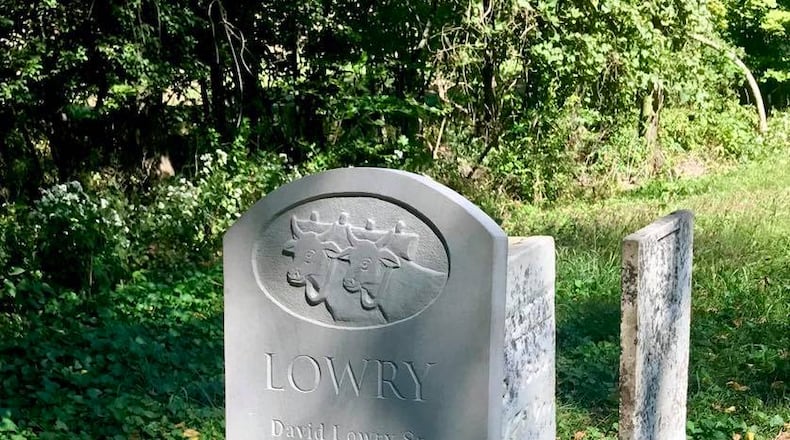David Lowry, Jr. and his friend Jonathan Donnel arrived here around 1795 or 1796, depending upon the source.
Donnel built his cabin on the land once occupied by the Shawnee, on a hill near where the Hertzler House now stands at George Rogers Clark Park.
Lowry built his cabin where Donnels Creek met the Mad River, not far from the location of Minnich Cemetery.
This graveyard is where David Lowry buried his parents in 1797 and 1800 and his first wife in 1801. Other relatives and neighbors with names like Minnich, Layton, McKinney joined them over the next decades. Some never had more than a field stone to mark their burial and their names are lost to history. The stones, mostly engraved marble, were erected years after the burials and did not hold up well.
For decades the cemetery fell into disrepair. Many of the stones degenerated naturally due to weather, freezing and thawing. Vegetation covered the broken stones and few markers remained visible.
It was one of David Lowry’s descendants, Miles Lowry, who decided that the cemetery needed a little bit of tender loving care. The Illinois resident who grew up near Port Clinton, said family knew of the location of the burial ground, but no one knew what to do about it.
Contacting Bethel Township officials, Miles was directed to Scott Suther, an authority on local and historic graveyards and member of the Medway Historical Society. He also sought out renowned tombstone restorer Casey Winningham. In September all three met at the Minnich Cemetery.
“The cemetery has an unusual shape,” said Scott Suther explaining that graves are in four separate but irregular sections. It is unknown why the irregularity, but that might be explained by trees, or vegetation long gone.
When the group began there were only five grave stones visible. It was known that Revolutionary War soldiers were buried there but none of the locations were known. Dave Suther, Scott’s brother, had for years put two American flags at the entrance of the burial ground for Memorial Day to denote the presence of veterans.
Using steel rods the men methodically tapped the first couple of inches of the surface in a grid and located the bases and the stones. Using that as the basis of a map they found the remnants of the engraved stones that were often in pieces.
Many of the stones were illegible, so Winningham worked on cleaning and making them as readable as possible. He was at least able to stabilize the stones to prevent further disintegration.
From a previous visit Lowry knew that his ancestor’s stones were not very legible, so he had arranged for Winningham to make a new stone that would have the names of five of the Lowry family buried there. At the top of the stone he decided to have a vintage style depiction of a team of oxen.
Lowry had found reference to a team of oxen in the estate papers of Archibald Lowry, so he decided that oxen would be a fitting illustration.
Winningham had already carved the stone in his shop in Indiana and the group placed the stone next to the locations of the Lowry graves and stones.
Lowry has learned much as he has researched those interred here. Among those buried close together was David Lowry, Sr who was born in Scotland and moved to Pennsylvania at a young age. He was indentured and ran away. Miles said that he found a runaway indentured servant ad seeking his ancestor in Ben Franklin’s newspaper. Eventually David Lowry Sr. and his wife Lettice joined son David Lowry, Jr. soon after the first cabin was built. Lettice was the first to be buried here in 1797.
David Lowry’s first wife Sarah Hamer Lowry was buried here in 1801. The stone commemorates Archibald Lowry’s family also.
“It looks more like a cemetery now,” said Suther, who is known for making huge improvements to local cemeteries with his brother, Dave.
All three men intend to continue their work on the project. Any historical or genealogical information that might help with the restoration project would be greatly appreciated, especially by Miles who would like to meet some local Lowry cousins.
Winningham is also available for additional restoration work in this area and for custom made stones. He can be contacted at (812) 327-3565. A gallery of his work can be viewed at www.caseywinningham.com
About the Author
